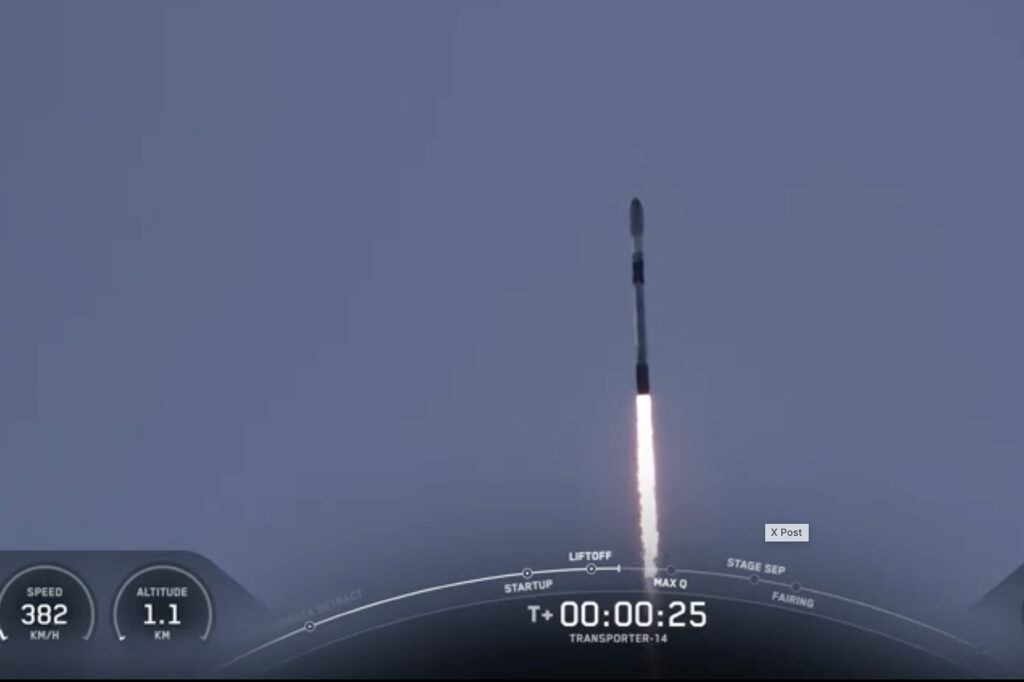
A SpaceX rocket launches Monday afternoon from Vandenberg Space Force Base to deliver the Transporter-14 mission, made up of 70 payloads for a variety of purposes.
VANDENBERG SPACE FORCE BASE, Calif. – A Falcon 9 rocket launched from Vandenberg Space Force Base on Monday afternoon, carrying symbolic samples of cremated remains into space as part of a Texas firm’s 25th memorial spaceflight.
Breaking: SpaceX Rocket Launches Memorial Payload
The two-stage rocket, built by SpaceX, lifted off at 2:25 p.m. from Space Launch Complex-4. This mission included 70 payloads for various purposes, with deployments beginning approximately one hour after liftoff and concluding successfully nearly two hours later, as confirmed by SpaceX.
26th successful liftoff and return of the first-stage booster, landing on a droneship in the Pacific Ocean.
Key Details Emerge
The cargo included a payload for Celestis Inc., carrying small samples of human cremains or DNA representing 166 people. Ahead of the launch, Celestis held a memorial ceremony in Lompoc, marking its 25th space burial mission since the firm’s inception 30 years ago.
Since its first mission in 1997, Celestis has facilitated memorial spaceflights for over 2,500 individuals from 35 nations, often hitching a ride on rockets delivering other payloads to space.
Industry Response
Charles Chafer, Celestis CEO, remarked on the unique nature of their Earth Rise flights, highlighting the opportunity for families to receive a flown capsule of their loved one as a keepsake. “We’re thrilled to provide this service,” Chafer stated.
Monday’s mission, known as the Celestis Perseverance Flight, was part of The Exploration Co.’s Mission Possible capsule, which included payloads for 25 other clients from more than 10 countries.
By the Numbers
- 166 individuals represented in the memorial payload
- Over 2,500 people memorialized since 1997
- Payloads from 10+ countries on this mission
What Comes Next
The Exploration Co. developed the Mission Possible capsule, which is set to return to Earth in a controlled re-entry using dual parachutes, splashing down in the Pacific Ocean between the Hawaiian and Aleutian Islands. Erika Wagner, lead for U.S. business development for The Exploration Co., highlighted the diverse nature of the payloads, including a Romanian fluid physics experiment and an art package from Israel.
Background Context
The first Celestis mission in 1997 originated from Vandenberg, with a Pegasus rocket carrying symbolic cremains of notable figures like “Star Trek” creator Gene Roddenberry. Subsequent missions have included other “Star Trek” cast members and everyday individuals, expanding the reach of space memorials.
Expert Analysis
Wagner emphasized the democratization of space access, noting, “This ecosystem of technology, science, art, and humanity is expanding daily.” The Mission Possible demonstration aims to validate critical systems such as propulsion and maritime recovery.
Regional Implications
Among other payloads, the mission included satellites designed to enhance maritime security, aiding in the rapid identification of vessels engaged in illegal activities and supporting search and rescue operations.
The mission’s impact on maritime security is significant, with satellites supporting global efforts to combat environmental crime and illegal fishing.
The launch from Vandenberg Space Force Base underscores the growing role of private companies in space exploration and memorial services, paving the way for future innovations and broader access to space.






